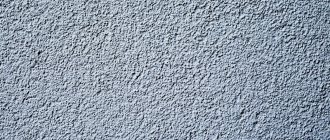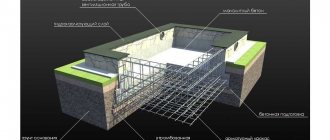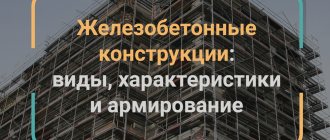Prestressed concrete belongs to the category of building materials, for the production of which high-strength steel reinforcement and concrete mixture are used. Thanks to special production technology, it resists significant tensile stress. Prestressed reinforced concrete is characterized by strength and increased crack resistance.
Definition
Prestressed reinforced concrete structures are a building material in which during production the concrete is subjected to the initial design compressive stress. During the manufacture of the material, tensile stress is pre-formed in steel reinforcement, which is characterized by a high level of strength. It is used to compress concrete in areas that will be subject to stress during operation.
During compression, no slipping of the reinforcement is observed, since it is fastened to the material and is anchored at the end. The reinforced concrete composition is reinforced, which helps balance the tension. If during operation the building material is exposed to useful loads, this does not lead to the formation of cracks, which prolongs its service life.
Production process
There are several ways to tension reinforcement:
The production of the material can be carried out using an electrothermal method.
- mechanical (screw or hydraulic jacks);
- electrothermomechanical (combination of the first and second methods).
electrothermal (steel rod is extended to the required values using electric current;
Tools and materials
Requirements are applied to prestressed concrete materials in accordance with existing regulatory documents:
Prestressed concrete structures are reinforced with the following materials:
- periodic profile reinforcement of class A-Shv, hot-rolled with drawing in its cold state;
- hot rolled sheet steel class At-V;
- reinforcing wire strands made of twisted wires.
Kawabanga! Ramp device
To carry out the process, it is necessary to prepare the following materials and tools:
For this work you will need mounting rods.
- rods (mounting, distribution);
- knitting wire;
- rod cutting tool;
- formwork panels for pouring concrete mixture.
Prestressing and work stages
With this production method, the prepared reinforcement must be stretched at the ends.
Reinforcing stress is produced mechanically, electrothermally, combined and physico-chemically.
Advantages
Prestressed concrete has certain advantages compared to similar materials:
- Reinforced concrete beams work well in compression and deflection relative to the center of gravity. They are characterized by a high level of strength along the entire length, which makes it possible to increase the length of spans to be covered. This ensures a reduction in cross-sectional dimensions, as well as a reduction in the weight and size of components.
- Concrete is a chemically neutral material, which eliminates the possibility of corrosion and deformation of reinforcement.
- The reinforcement compresses the concrete of the assembly units, which eliminates adhesion resistance and reduces metal consumption at the joint.
- Reinforced concrete structures can consist of joined parts and have the same cross-section, which ensures resistance to external loads. The structures are characterized by increased endurance, which is ensured by compensation of repeated dynamic impacts.
- Prismatic strength makes it possible to dampen changes in reinforcement and concrete that appear when the external load fluctuates.
- When using building materials, the possibility of deformation of concrete and reinforcement is eliminated, which guarantees increased seismic resistance of the building.
The prestressed type of structure is safe. Thanks to the extreme deflection, which signals the exhaustion of strength, it does not collapse.
Advantages of prestressed reinforced concrete frames
- • significant reduction in the amount of steel (30-45%);
- • increased resistance to cracking, preventing corrosive destruction of structures operating in aggressive environments and requiring additional impermeability to liquids and gases;
- • increasing the level of rigidity and decreasing deflection;
- • reduction in the volume of concrete mixture and the weight of structures as a result of the use of high-quality cement;
- • minimizing the cross-sectional dimensions of functional parts of the structure and rationalizing their use.
Flaws
In order to ensure prestressing of reinforced concrete structures, it is necessary to use special equipment. Products require careful storage, proper transportation and professional installation. This will not lead to the emergency condition of the building material even before its operation.
Production requires accurate calculation of prestressed reinforced concrete structures, which is carried out by highly qualified specialists. If there are miscalculations in design and inaccuracies in production, the reinforced concrete structure being created can completely collapse.
Longitudinal tensile stress will lead to the appearance of cracks, which will reduce the load-bearing capacity.
To ensure axial tensile strength, metal-intensive formwork must be used. This increases steel consumption.
In order to ensure heat and sound conductivity, it is necessary to use compensating materials. Such structures are characterized by a lower fire resistance threshold.
In accordance with the essence of prestressed reinforced concrete, it can be concluded that it does not tolerate the effects of alkalis, salts, acids, etc. In this case, there is a decrease in the load-bearing capacity of the products, as well as their destruction. The disadvantage of the design is their impressive weight.
Prestressed concrete structures
Essence.
Over a long period of time, the loss of reinforcement prestress increases significantly due to shrinkage and creep of concrete and reinforcement, relaxation of reinforcement stresses and many other factors.
The established pre-tensile stress in the reinforcement (Fig. 15, a, point 2) will be balanced by the pre-compression stress of the concrete (Fig. 15, b and c).
With these prestresses in the reinforcement and concrete, the reinforced concrete element (see Fig. 15, c) arrives at the construction site.
Kawabanga! Concrete caps for fence posts
Let us consider the fundamental difference between prestressed structures and structures without prestress.
Even before the application of an external load, significant preliminary tensile stresses act in the reinforcement of prestressed structures (see Fig. 15, a, point 2), compressing the concrete of the elements (see Fig. 15, b and c).
External tensile force N (Fig. 15, d) causes a relative elongation of the prestressed element. As a result, the preliminary compression of the concrete will be extinguished.
With increasing external load N, e will increase up to the value of elastic compression of concrete.
Advantages.
Flaws.
Reinforced concrete structures with prestressed reinforcement have the following main disadvantages.
The high thermal and sound conductivity of reinforced concrete requires a more complex design and the additional use of gaskets made of heat and sound insulating materials.
Prestressed structures are characterized by insufficient corrosion resistance.
Corrosion of cement stone in concrete can occur due to:
1) leaching of lime from it with soft waters, causing the formation of white smudges on the surface of the concrete (“white death” of concrete);
2) the formation of soluble and water-carried products associated with metabolic reactions when solutions of acids and some salts act on concrete;
The main measures to protect reinforced concrete from corrosion are as follows:
– preventing the formation of cracks or limiting their opening;
– limiting the degree of environmental aggressiveness;
– the use of dense and waterproof concrete using special sulfate-resistant cements;
– protection of surfaces with a variety of polymer materials, acid-resistant plaster, ceramic cladding, adhesive and coating insulation;
– overconsumption of fittings up to 10.20%; increasing the protective layer of concrete up to 25 mm.
Oil and its effluents reduce the tensile, compressive strength of concrete and the adhesion to reinforcement, as a result of which the concrete becomes permeable to liquids.
Vegetable and animal oils and fats, especially rancid ones, contain fatty acids that saponify the lime of concrete and form lime soap that destroys concrete.
Sugar, syrups, and molasses form soluble salts with lime - saccharates, which quickly destroy fresh concrete.
That is why, despite the short history of development (
Didn't find what you were looking for? Use the search:
Best sayings:
When passing laboratory work, the student pretends that he knows everything;
the teacher pretends to believe him. 9941 – | 7563 – or read all.
Materials for structures
Reinforced concrete belongs to the category of multicomponent building materials. It consists of concrete and steel reinforcement. During the design of reinforced concrete, the quality parameters of materials are determined in accordance with GOST standards.
Concrete
To ensure prestressing and resistance of concrete, only heavy compounds are used, the density of which is 220-2500 kilograms per square meter.
The mixture is infused for at least 28 days, which will allow the material to be pre-stressed. At the initial stage of operation, a partial loss of the stressed quality of concrete may be observed, which is explained by a decrease in the tension of steel elements. The determination of the normal cross-section of a reinforced concrete element is carried out in accordance with the design and requirements for further operation.
Armature
Steel reinforcement must be stressed and resistant to tension during its entire service life. It is able to withstand loads for a long time, which will eliminate the possibility of cracks opening in the concrete. For the production of building materials, high-strength steel is used, which has low fluidity. The design characteristics of steel must fully correspond to the creep of concrete.
In order to compensate for the operational loss of a certain value of prestress, during production the value is set slightly higher than specified in the design documentation and requirements for the finished material.
The production of reinforced concrete structures is carried out using reinforcing wire:
- Packages;
- Strands;
- Puchkov.
Reinforced concrete structures are manufactured using cold-deformed, hot-rolled reinforced reinforcement, welded frames, and ropes. The cross-sectional area of the reinforcement directly depends on the size of the finished reinforced concrete product. The wire and ropes have a crescent-shaped and annular cross-section, and the reinforcement is smooth and periodic. The steel must have adequate shear force. The fluidity of the metal in relation to elongation should be 0.2 percent.
In accordance with the parameters of the stretched fiber, the strength class of the reinforcement should be 0.95 or more. It must be characterized by cold resistance and plasticity. The optimal force in the prestressing reinforcement is ensured by the formation of a complex spatial surface. That is why the material must be weldable.
The tension of the reinforcement during production is ensured by mechanical or electrothermal methods. In the first case, this is achieved using weights, jacks and levers. The electrothermal method requires preparing rods of the required length, at the ends of which anchors are located. They are heated to 400 degrees, which causes them to elongate. In this state, the reinforcement is secured to the supports. When cooling, the rods shorten, but the anchors do not allow this to happen, which leads to stress.
World experience in using prestressing technology
Toronto TV Tower
Platform "Troll"
Normandy Bridge
Most of the world's monolithic reinforced concrete is prestressed. First of all, long-span structures, residential buildings, dams, energy complexes, television towers and much more are erected in this way. Television towers made of monolithic prestressed reinforced concrete look especially impressive, having become landmarks in many countries and cities. The Toronto Tower is the world's tallest free-standing reinforced concrete structure. Its height is 555 m.
The cross-section of the tower in the form of a trefoil turned out to be very successful for placing prestressing reinforcement and concreting in slip formwork. The wind overturning moment for which this tower is designed is almost half a million tonmeters, with the dead weight of the ground part of the tower being just over 60 thousand tons.
In Germany and Japan, egg-shaped tanks for wastewater treatment plants are widely built from monolithic prestressed reinforced concrete. To date, such reservoirs have been built with a total capacity of more than 1.2 million cubic meters. Individual structures of this type have a capacity from 1 to 12 thousand cubic meters.
Abroad, monolithic floors of extended span with reinforcement tensioned on concrete are becoming increasingly used. In the USA alone, more than 10 million cubic meters of such structures are erected annually. A significant amount of such floors are being constructed in Canada.
Recently, prestressed reinforcement in monolithic structures is increasingly used without adhesion to concrete, i.e. Channels are not injected, and the fittings are either protected from corrosion with special protective shells or treated with anti-corrosion compounds. This is how bridges, long-span buildings, high-rise structures and other similar objects are erected.
In addition to traditional construction purposes, monolithic prestressed concrete has found wide application for reactor vessels and containment shells of nuclear power plants. The total capacity of nuclear power plants in the world exceeds 150 million kW, of which the power of stations whose reactor vessels and containment shells are built from monolithic prestressed reinforced concrete is almost 40 million kW. Containment shells for nuclear power plant reactors have become mandatory. It was the absence of such a shell that caused the Chernobyl disaster.
A striking example of the construction capabilities of prestressed concrete are offshore oil platforms. More than two dozen such grandiose structures have been erected in the world.
Built in 1995 in Norway, the Troll platform has a total height of 472 m, which is one and a half times higher than the Eiffel Tower. The platform is installed in a sea area with a depth of more than 300 m and is designed to withstand the impact of a hurricane storm with a wave height of 31.5 m. 250 thousand cubic meters were spent on its production. high-strength concrete, 100 thousand tons of ordinary steel and 11 thousand tons of prestressed reinforcing steel. The estimated service life of the platform is 70 years.
Traditionally, a wide area of application of prestressed reinforced concrete is bridge construction. In the USA, for example, more than 500 thousand reinforced concrete bridges with various spans have been built. Recently, more than two dozen cable-stayed bridges with a length of 600-700 m with central spans from 192 to 400 m have been built there. Extracurricular bridges are constructed from pre-stressed reinforced concrete, which are built according to individual projects. Bridges with a span of up to 50 m are erected in a prefabricated version from reinforced concrete prestressed beams.
Achievements in bridge construction using prestressed reinforced concrete are also available in other countries. In Australia, in Brisbane, a beam bridge was built with a central span of 260 m, the largest among bridges of this type. The Barrnos de Luna cable-stayed bridge in Spain has a span of 440, the Anasis in Canada - 465, the bridge in Hong Kong - 475 m. The arch bridge in South Africa has the largest span - 272 m. The world record for cable-stayed bridges belongs to the Normandy Bridge , where the span is 864 m. The Vasco de Gama Bridge in Lisbon, built for the World Exhibition EXPO-98, is not much inferior to it. The total length of this bridge crossing exceeds 18 km. Its main supporting structures - pylons and spans - are made of concrete with a compressive strength of more than 60 MPa. The guaranteed service life of the bridge is 120 years based on the durability of concrete (in Russia, in recent years, long-span bridges are more often built from steel).
Areas of use of structures
The use of prestressed structures is recommended when it is not practical to use conventional reinforced concrete. They are an ideal option when load-bearing strength is required. The use of stressed reinforced concrete structures is carried out in various fields of construction - industrial, civil, special, hydraulic.
Reinforced concrete structures are used for the construction of bridges that have wide spans. They are recommended for use in the construction of pressure pipelines and dams. Using reinforced concrete products, waterproof containers are installed.
The structures are widely used to create retaining walls and enclosing panels. If there is a need to build a foundation or flight of stairs, then reinforced concrete structures are used. They are used for the construction of premises in seismic and explosive areas. Prefabricated monolithic structures are formed using reinforced concrete products. They consist of connecting individual prestressed precast elements with reinforcement. Columns and power line poles are erected using reinforced concrete structures. Using them, tunnel frames are created.
Production process
There are several ways to tension reinforcement:
The production of the material can be carried out using an electrothermal method.
- mechanical (screw or hydraulic jacks);
- electrothermal (steel rod is extended to the required values using electric current;
- electrothermomechanical (combination of the first and second methods).
Tools and materials
Requirements are applied to prestressed concrete materials in accordance with existing regulatory documents:
- GOST 5781–82;
- SP 52-102-2004.
View “GOST 5781-82” or download in PDF (462.7 KB)
Prestressed concrete structures are reinforced with the following materials:
- periodic profile reinforcement of class A-Shv, hot-rolled with drawing in its cold state;
- hot rolled sheet steel class At-V;
- reinforcing wire strands made of twisted wires.
To carry out the process, it is necessary to prepare the following materials and tools:
For this work you will need mounting rods.
- rods (mounting, distribution);
- knitting wire;
- rod cutting tool;
- formwork panels for pouring concrete mixture.
Kawabanga! Main types of reinforced concrete structures
Prestressing and work stages
With this production method, the prepared reinforcement must be stretched at the ends.
Reinforcing stress is produced mechanically, electrothermally, combined and physico-chemically.
Pre-tensioning of reinforcement
Hydraulic stops are used to tension reinforcement in production.
The pre-tensioning method involves laying and tensioning the reinforcement first, and then covering it with mortar. The tension of the heavy-duty steel reinforced wire is maintained until the concrete is strong enough. After this, the wire is cut, and its tension is transferred to the mixture due to adhesion to it. Due to this, the concrete is subjected to compressive stress, and production is completed.
Features of the calculation of prestressed structures
The static moment of the reduced section relative to the 1-1 axis passing along the lower edge of the section,
where A is the area of part of the section; уi is the distance from the center of gravity of the i-th part of the section to the 1-1 axis.
Distance from the center of gravity of the reduced section to axis 1-1
Moment of inertia of the reduced section relative to the axis passing through the center of gravity of the reduced section where Ii is the moment of inertia of the i-th part of the section relative to the axis passing through the center of gravity of this part of the section.
The distances to the upper and lower boundaries of the core of the section from the center of gravity of the reduced section are:
The eR value is determined by the formula
Calculation of the strength of sections of bending elements is carried out from the condition
It is allowed to determine the voltage os using the formula
where z is the distance from the center of gravity of the reinforcement located in the tension zone of the section to the point of application of the resultant forces in the compressed zone of the element; esp is the distance from the center of gravity of the same reinforcement to the point of application of force Np.
For elements of rectangular cross-section in the absence (or without taking into account) compressed reinforcement, the value of z is determined by the formula
where xN is the height of the compressed zone, determined taking into account the influence of the preliminary compression force Np.
Voltages. os, determined by formulas (93), should not exceed Rs,ser—osp. Otherwise, the calculation is similar to the calculation of elements with non-prestressing reinforcement.
It is allowed for elements of rectangular section to determine the height of the compressed zone using the formula
The curvature of bending prestressing elements can be determined by the formula











